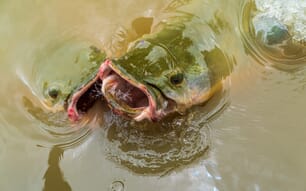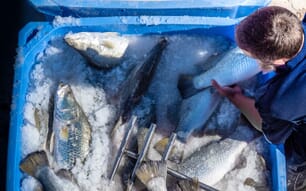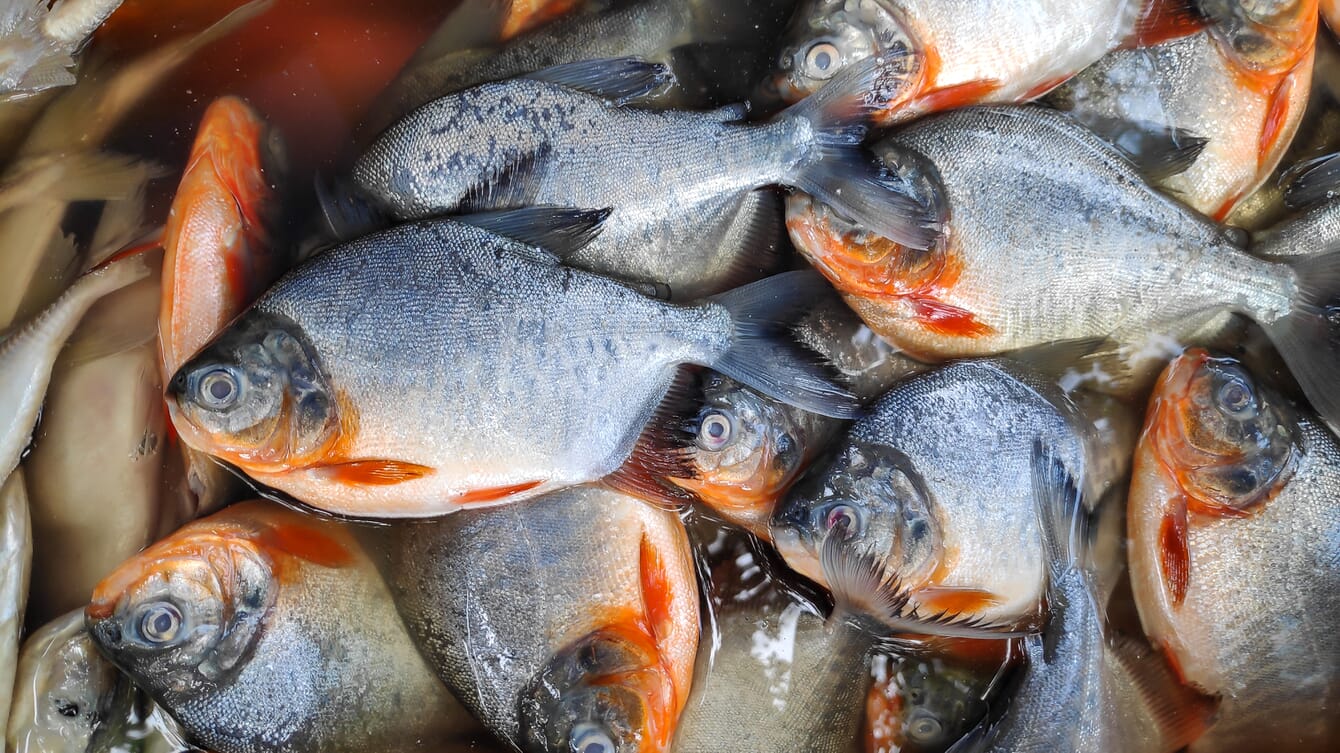
Pirapitinga is the most widely used name for this species in South America
Several distinct types of fish are called “pacu” in various parts of the world, but increasingly the term is used to refer to a group of closely related South American species with overlapping natural ranges and ecological niches. These fishes are currently classified in the family Serrasalmidae, although the taxonomy and systematics of the group are far from being finalised. As characiform fishes, they are related to many species seen around the world in aquaria, and also to piranhas. Some sources suggest the name pacu originally meant “quick eater” in the South American Tupi-Guarani languages, in keeping with these animals’ flexible appetites and rapid growth rates.
Principal species
Colossoma macropomum is probably the most widely cultured of the group. It goes by various names throughout its natural range, including tambaqui, gamitana, cachama and pacu negro. They are the largest characiform fish to be found in their natural range, which includes the Amazon and Orinoco rivers and their surrounding watersheds, and they occasionally approach 40 kg. Since pre-colonial times, C. macropomum has been an important resource, due to the quality and flavour of its flesh. For the rest of this article we will refer to this species as tambaqui.
In the wild, the diet of C. macropomum is primarily fruits, nuts and seeds, supplemented with invertebrates (crustaceans, insects and snails), small fish and zooplankton. Unfortunately, the zooplankton component of the diet is a frequent disease vector for an acanthocephalan parasite that can cause significant stunting. These fish prefer lentic habitats in forested floodplains. They migrate upriver in large groups during the spawning season, before returning downstream to rest, recover and continue their leisurely lifestyle.
Piaractus brachypomus is also widely cultured, but not necessarily where it occurs naturally. Pirapitinga is the most widely used name for this species in South America. As adults these fish are quite similar in appearance to tambaqui, but juveniles display bright red coloration on the chest and ventral area, earning the species the common name “red-bellied pacu” among English speaking aquaculturists and aquarium enthusiasts. Their natural range and habitats overlap broadly with those of tambaqui, and hybrids are occasionally found in the wild. Such hybrids are also frequently raised in aquaculture facilities (see below). Pirapitinga are primarily vegetarian, but like their tambaqui cousins they also eat invertebrates and small fish when their preferred diet is limited.
Piaractus mesopotamicus, known as the small-scaled pacu, or just plain “pacu”, is native to the Paraguay-Parana watershed, but has been widely introduced to other areas in South America. They can reach weights of up to 20 kg, and are recognisable by their small scales and greyish coloration, offset by a yellowish chest and white underbelly. These fish are also primarily vegetarians but they will consume insects when they are available. They are somewhat more tolerant of cooler temperatures than the tambaqui and pirapitinga.
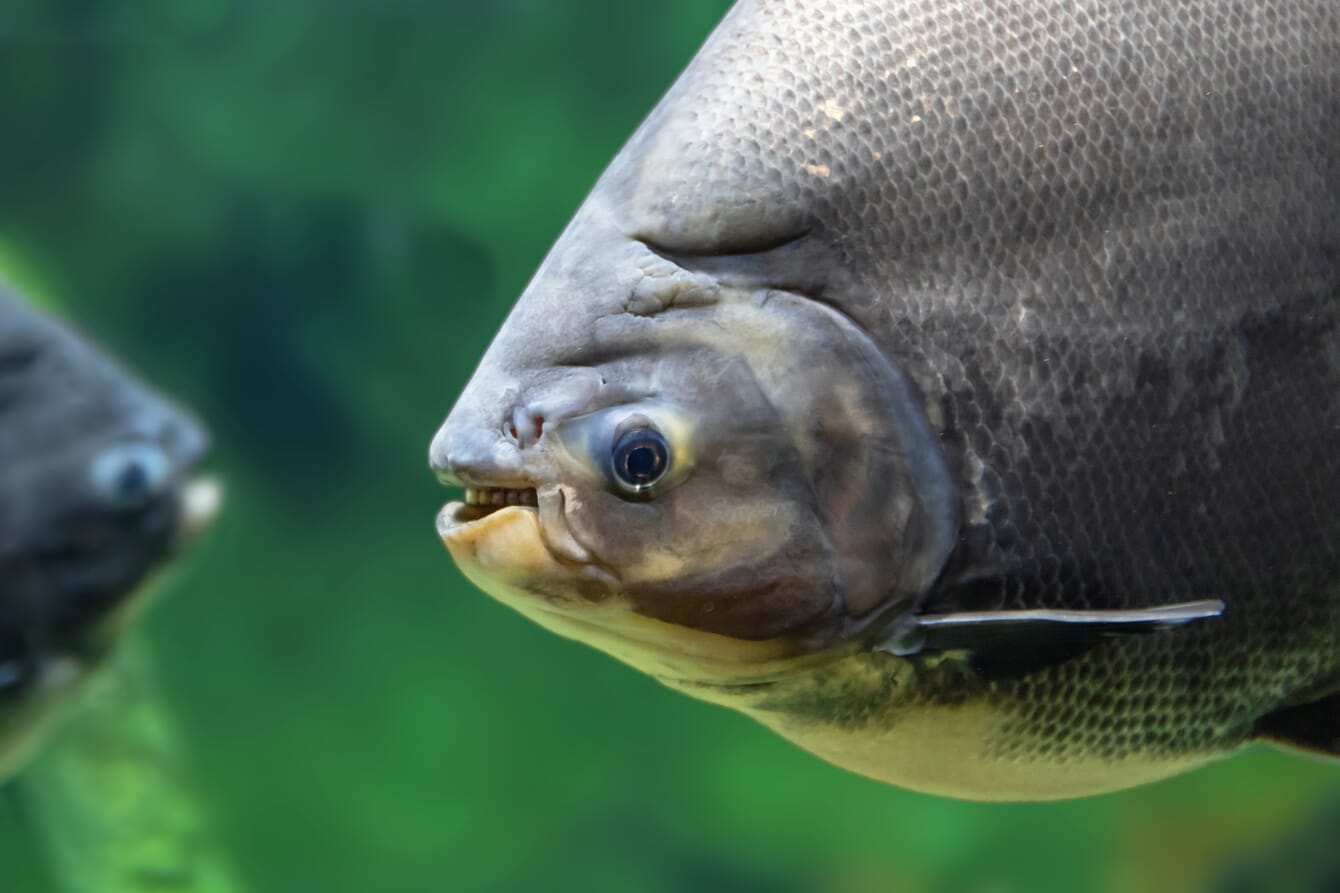
They are the largest characiform fish in the Amazon and Orinoco rivers
History of pacu culture
Interest in culturing pacu can be traced back to the 1930s, but serious efforts to develop methods for commercial production only began in the 1960s and 1970s. As is the case with other successful warmwater aquaculture species such as tilapia and tra, tambaqui and their relatives are capable of utilising a number of common ingredients found in manufactured feeds. Their acceptance of plant-based proteins bolsters their sustainability credentials, while keeping feed costs down. They are adaptable to various production practices and levels of management intensity. Their rapid growth and tolerance of low oxygen and sub-optimal water quality have earned them a place in commercial aquaculture industries in a number of countries.
These fish also lend themselves to induced spawning and are highly fecund. By the 1980s reliable spawning and hatchery techniques began to allow for widespread commercial availability of fingerlings. Unfortunately, these high fecundity levels result in very small larvae, which require live feeds for several days post-hatch. But apart from this requirement, hatchery methods are straightforward and generally result in high survival.
Over the past three decades production of tambaqui and its relatives has increased in a number of countries in the Americas and Asia. Although some producers in South America have subsequently shifted their focus to tilapia, tambaqui is now being farmed from Brazil to Honduras. In 2009, researchers in India published methods for induced spawning of pirapitinga (the red-bellied pacu) and over the following decade production levels and sales prices increased significantly there and throughout the surrounding region.

Current status and trends
The pacus are adaptable to a number of production approaches, ranging from low-density extensive pond culture to high-density intensive systems. Semi-intensive ponds can routinely produce annual yields of up to 10 tonnes per hectare of tambaqui. While this species can also be cultured in cages, it does not perform as well in high-flow systems such as in-pond raceways. This is probably the case for pirapitinga and small-scaled pacu as well, since all three species are naturally found in calm, slow-moving floodplain waters.
In Brazil, tambaqui have performed well in polyculture ponds with Macrobrachium, common carp, grass carp, catfish (Prochilodus) and tilapia. Indian producers also report good results when raising red-bellied pacu in polyculture with Indian major carps. Seshagiri et al. (2022) provided an interesting overview of modern red-bellied pacu culture in India, outlining similarities with, and differences from, tambaqui production in Brazil.
Introductions of the three pacu species to many tropical countries and regions were already taking place by the mid-1980s. Some notable examples include Malaysia, Indonesia, Taiwan, Mexico, China and the Philippines. In many instances, these introduced fish have shown invasive and injurious tendencies when released into watersheds outside their natural range. In recent decades these species seem to have become increasingly widespread in tropical nations like India, Thailand, Vietnam and Papua New Guinea, with many reports of introduced populations demonstrating a shift in their natural vegetarian diet, consuming more animal species (fish, crustaceans and molluscs) and less fruits and nuts.
While individual tambaqui have been collected from natural waters in temperate regions such as Turkey, Poland, Hungary, Iran and Croatia, they cannot overwinter in these habitats without access to some sort of long-term thermal refuge. Similarly, researchers in Israel have reported lower lethal temperatures of 7.0 – 7.5 °C for P. mesopotamicus and P. brachypomus, indicating that overwintering procedures or refuges are required for survival of these species as well.
High fecundity, comparatively large size upon reaching maturity and the resulting tendency to maintain small numbers of tambaqui broodstock also appear to have been at least partly responsible for widespread reductions in genetic variation in cultured stocks throughout South America. Many of these losses have not been compensated for by selective breeding practices, although a number of publications suggest great potential for genetic improvement in this species. Industry accounts from India suggest a similar phenomenon may be occurring there for the introduced red-bellied pacu.
A number of hybrid pacu have been produced in Brazil over the years with the goal of producing faster growing, more cold tolerant and generally hardier fish. While naturally occurring hybrids are occasionally seen wherever species’ ranges overlap, this practice has raised increasing concern over the potential for deleterious introgression in wild populations resulting from escaped farmed hybrids. Typically, female tambaqui are crossed with male small-scaled or red-bellied pacu, producing “tambacu” and “tambatinga,” respectively. There is also a hybrid known as “paqui” which is the result of crossing female small scaled pacu with male tambaqui.
Nutritional requirements for these fish are largely satisfied by available commercial diets, but there is room for substantial refinement of feed formulations to improve performance and reduce costs. A number of pathogens can cause disease and mortality in tambaqui and its relatives, especially under climatic conditions that would not typically occur in their natural habitats. Although control methods and treatments are becoming increasingly familiar to producers in various countries, there is an acute shortage of therapeutic compounds that are actually licensed and registered for use with the fish.
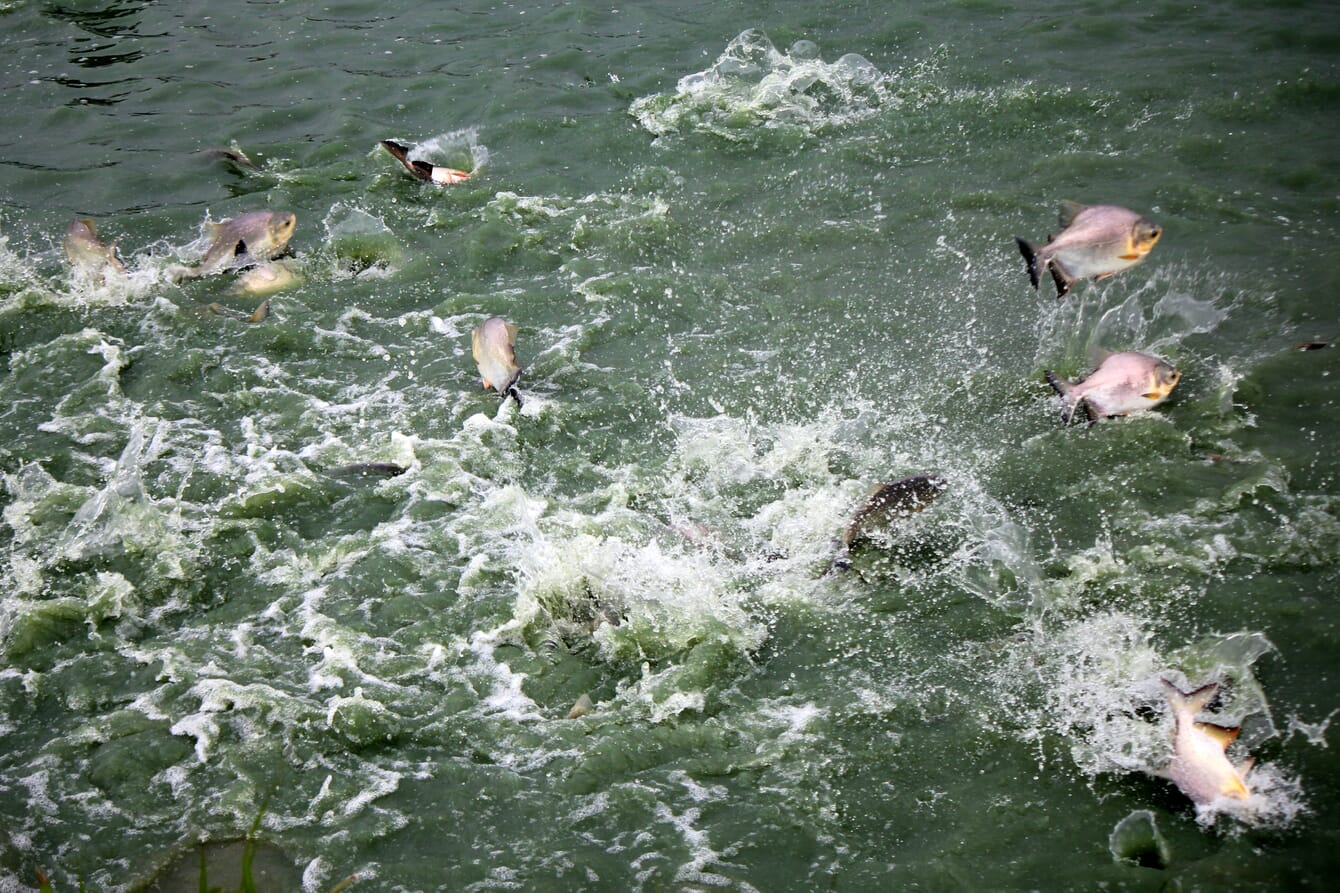
When it comes to the various species and hybrid pacus, markets often demand a fairly large size at harvest (>1 kg) to facilitate removal of intramuscular Y bones. Removal of these bones during processing is labour-intensive, and any that are missed can pose a choking hazard. One consequence of this emphasis on larger size at harvest has been the establishment of export markets for “pacu ribs.” While researchers elsewhere have tried to address this Y bone issue in carp by applying modern molecular methods this may eventually be less of a problem for Colossoma and Piaractus producers.
In 2016 Perazza et al. reported on the identification of a hatchery population of tambaqui in Brazil in which a number of breeders lacked intramuscular bones. This condition appeared to have a heritable component, inasmuch as the group of breeders in question had attracted attention based on the fact that fingerlings from at least one spawning event the prior season also had no intramuscular bones. X-ray imaging and ultrasound screening indicated 28 out of 120 fish either completely lacked, or had only vestigial, intramuscular bones.
In a follow-up investigation Nunes et al. (2020) used a genome-wide association study to identify markers associated with the absence of intramuscular bones. They identified 675 genetic markers with significant associations for total or partial bone loss, although most had only minor influence. Interestingly, the mean heterozygosity of fish without intramuscular bones was more than twice as high as in normal fish, and full-sib and half-sib relationships were evident both within and among fish with total, partial or no loss of intramuscular bones. These findings are only preliminary, and the genetic control over this trait may yet prove too complex to allow for efficient breeding programmes, but the potential for tambaqui stocks free of intramuscular bones is an intriguing possibility. Another published study reported significant variation in the numbers of intramuscular bones in tambaqui, with values ranging from 36 to as few as four in a sample of 127 juveniles from a single family.
The future
While the fish discussed here may never challenge tilapia, carps or catfishes to dominate global aquaculture production, they have displayed a number of attractive characteristics. Their production and value is increasing in several parts of the world and, if the problem of intramuscular bones can eventually be solved, harvests may increase exponentially.


